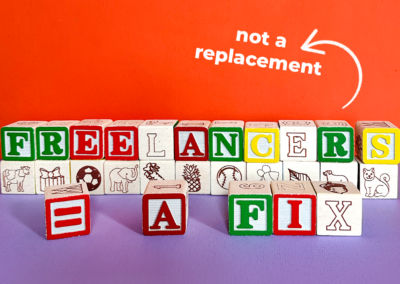It’s no secret that we’re advocates for the layered workforce. By bringing together full-time, part-time, freelance, remote, hybrid, and in-office workers in flexible ways, companies can spark greater innovation, inclusion, growth, and employee wellbeing.
In the 2023 Rosie Report, marketers who are part of layered teams acknowledged the benefits. Fifty-seven percent reported having “more thoughtful and creative output” thanks to the inclusion of different perspectives. Additionally, 46% of those surveyed said they “are able to divide and conquer the work better based on their strengths.”
Sounds like a win-win, right?
It is—if you’re prepared to navigate a complex set of labor laws. That includes the most recent U.S. Department of Labor rule for determining whether a worker is an independent contractor or employee, which will take effect March 11 to address the growing freelancer economy.
The updated guidance reiterates and clarifies something we’ve known at We Are Rosie since day one: many of the people you think of as freelancers aren’t actually freelancers in the eyes of the law.
There’s no cutting corners on worker classification compliance
Our nearly six-year-old company launched amidst the evolution of the gig economy, when lawsuits over worker classification were everywhere, and the list of companies that have faced this type of litigation (and paid out millions of dollars as a result) continues to grow today.
That’s part of the reason we’ve always been obsessed with compliance.
As we pitched a new, more inclusive way of working to the biggest brands and agencies in the world, we had to give them every reason to partner with us. Any issues with our ability to be compliant would be a dealbreaker because our clients know what’s at stake with worker misclassification, from the financial risk to the PR nightmare.
Then, just as now, our clients engaged our consultants (who we lovingly call Rosies) to add extra skills to their team, increase bandwidth, provide coverage during an employee leave, and produce special projects and campaigns from start to finish.
These aren’t the only ways to utilize the amazing talent we have in our community, but they are some of the most common. And they almost always require us to classify Rosies as employees, not contractors, and to report their income on a W-2 rather than a 1099 tax form.
What makes a worker an employee vs. a contractor: the A-B-C test
It used to be a little murkier, but the U.S. Department of Labor and courts have created guidelines in recent years to clarify when a worker is an employee; this means they’re entitled to benefits, protections, overtime pay, and more.
In 2018, California’s Supreme Court created the so-called “A-B-C” test. This states that unless the employer can demonstrate the following three items, they should assume the worker is an employee:
A. Worker is free from control of the employer in both the contract and the actual work
B. The work performed is outside the usual scope of the employer
C. The worker is “customarily engaged” in independent work
Let’s put it this way: If you hire a plumber to fix a leak in your office bathroom, you would treat and pay them as an independent contractor. The work they’re doing is totally unrelated to how you make revenue, and you’re not directing them in their work (at least we hope not).
If you’re a consumer goods or tech company and you hire an independent marketer to work alongside your team (physically or virtually), performing similar duties for a few months, then you would fail to demonstrate at least A and B of the A-B-C test. So, even if they’re working less than 40 hours a week and making their own schedule, technically they’re still an employee.
The Fair Labor Standards Act’s new contractor rule
The Department of Labor has built upon the judicial precedent by publishing its final rule under the Fair Labor Standards Act as recently as January 10, 2024. This rule for determining whether someone is an employee or independent contractor sets out an economic reality test that relies on six general “economic reality factors” to guide the analysis of the employment relationship.
Although the list is considered comprehensive, it is not exhaustive—meaning other factors can come into play when determining whether someone is a contractor or an employee under the eyes of the law.
Let’s look at the six factors below and break down what each of them means.
- Opportunity for Profit or Loss Depending on Managerial Skill: If the worker doesn’t have an opportunity for profit or loss, this factor points toward them being an employee.
- Investments by the Worker: If the worker invests in things such as tools to perform the work, like the plumber buying copper piping or office space, that suggests independent contractor status.
- Degree of Permanence: For this factor, the Department of Labor compliance guide poses, “Is the work relationship indefinite in duration, non-exclusive, project-based, or sporadic based on the worker being in business for themself and marketing their services or labor to multiple businesses? That would weigh in favor of the worker being an independent contractor.”
- Nature and Degree of Control: This factor considers whether the employer sets the worker’s schedule, supervises the performance of work, limits their ability to work for others, and more.
- Extent That the Work Performed Is an Integral Part of the Business: The Department of Labor explains that if “the function they perform is an integral part of the business,” that suggests the worker is an employee.
- Skill and Initiative: This one comes down to the worker having specialized skills and those skills contributing to “business-like initiative.”
We realize that the majority of our clients’ engagements with our Rosies don’t pass the economic reality test for independent contractors. By law our Rosies must be properly classified as W-2 employees, not 1099 consultants which makes our way of working an added benefit to our clients.
When W-2 vs 1099 is about more than tax law
In the very early days, we reduced our risk (and our clients’) by hiring all of our Rosies as direct employees of We Are Rosie.
Was it foolish for a months-old startup to do this? Maybe. Was it the right thing to do at the time, for both our clients and our Rosies? Absolutely. We were investing so much of ourselves into growing We Are Rosie that cutting corners would not have honored that effort.
Our founder, Stephanie Nadi Olson, built We Are Rosie to create a workplace environment that treats everyone with dignity and offers access to opportunity, especially for historically marginalized groups. Regardless of the legalities, choosing to treat our Rosies as independent contractors would have contradicted our mission..
One of the reasons why we’ve seen so many lawsuits about worker classification is because people lose out on a lot when they aren’t employees. They don’t get the right to employer-sponsored health insurance, which is one of the biggest concerns for Rosies who are leaving a full-time job to work with us. They end up paying more taxes since the company isn’t covering half of their Medicare and Social Security contributions, and they typically miss out on the possibility to collect unemployment insurance when they’re out of work.
Independent workers are also solely responsible for any legal action from clients, and therefore must carry large business insurance plans, produce buttoned-up contracts, and be ready to financially support any legal implications that may arise.
So yes, as a freelancer, you might get to make your own hours and set your own rates, but we don’t think flexibility and employee protections should be mutually exclusive. We proudly offer our working Rosies a full suite of benefits, including access to a 401k retirement savings plan and our “Rosie Refresh” personal and professional development stipend.
Staying compliant as a start-up
Our team specializes in helping companies solve their marketing problems and become more agile, innovative, and resilient. This is our area of expertise and our passion; early on, we made the decision to stay laser focused on it.
So, after a few months of hiring every Rosie as an employee (despite the fact that they were spread across several states with varying labor laws and requirements), we partnered with an organization that is as knowledgeable about labor law compliance as we are about marketing.
Today, we use an industry-leading workforce management platform, which makes it possible for us to onboard Rosies quickly and to rest easy knowing each one of them is classified properly on every single project.
Working with freelancers is essential—but it requires good partners
The gig economy isn’t going anywhere, and as far as our industry is concerned, more and more marketers continue to opt in to independent work, whether for their main source of income or as a supplement to a full-time job.
The proof is in our very own community of independent marketers: In 2023, it grew by over 30%, and our data suggests that about 20% of all Rosies have experience as senior leaders. In other words, the people you want and need to set your business and brand apart are choosing flexible work. If you don’t adjust your ways-of-working philosophy, you’ll sacrifice the opportunity to benefit from their talents.
But where does that leave you, if hiring these top freelance marketers is legally complicated?
Don’t let it scare you away from using flex talent. Do let it motivate you to find the right partners who take compliance seriously. Freelance workers aren’t going anywhere—we just need to think a little differently about how we engage and value them as we build a more human and inclusive (and yes, compliant) workforce.



